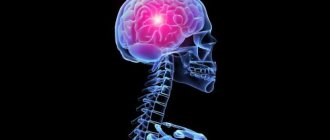Professional self-determination as the main criterion for professional development
Of course, in life a person is faced with various types of self-determination, and not just professional ones, so the signs of any self-determination are distinguished:
- a person’s establishment of his own characteristics, traits, qualities, abilities;
- selection of criteria and norms for self-evaluation;
- identification of qualities that already correspond to the selected criteria and standards, acceptance or non-acceptance of oneself;
- anticipation of one's potential qualities;
— building your goals, objectives, plans;
— change in value orientations and revision of existing evaluation criteria;
- re-self-determination - a person re-accepts or does not accept himself [2].
The process of self-determination is very dynamic. A person either raises the “bar” of criteria or lowers it depending on his achievements, level of aspirations, and circumstances.
N.S. Pryazhnikov [11] developed a content-procedural model of professional self-determination, which includes a number of components of this process.
1. Awareness of the value of socially useful work and the need for professional training.
2. Orientation in the socio-economic situation and forecasting the prestige of the chosen work.
3. General orientation in the world of professional work and identification of professional goals.
4. Determination of immediate professional goals.
5. Information about professions, specialties, educational institutions, places of employment.
6. An idea of the obstacles to achieving professional goals and knowledge of one’s strengths that contribute to the realization of goals.
4 pp., 1531 words
Professional personal development: the beginning of the journey. Empirical research Team of authors, 2020
2.1 Level and content characteristics of professional self-determination
The initial stage of professional self-determination, including the process of forming professional intentions and choosing a profession, is quite widely represented in the psychological literature. As the authors of the studies show, the desire to find one’s place in life (including in professional activity), the need for professional self-determination is one of the important psychological developments of high school age (Bozhovich, 1997; Kon, 1982, etc.). Responding to new expectations of society, high school students are intensifying the search for a profession that can satisfy these expectations, as well as their personal needs, which are largely determined by the level of development of the motivational sphere. To this end, they analyze their capabilities from the point of view of developing professionally significant qualities in themselves, and form a self-assessment of their own professional suitability (in the broad sense of this term).
Klimov E. A. (2007) understands professional self-determination as a human activity that takes on one or another content depending on the stage of its development as a subject of labor. The content of the activity is, first of all, images of the desired future, the result (goal) in the mind of the subject, the features of his self-regulation, the features of self-awareness, his personal qualities and his place in the system of business interpersonal relations.
Professional self-determination is considered, on the one hand, as a significant component of a person’s professional development, and on the other hand, as a criterion for one of the stages of this process. The latter approach allows us to introduce the concept of the level of professional self-determination and consider its indicators at each specific age stage.
Professional self-determination is a complex dynamic process that has a multicomponent structure, including level and content characteristics. Senior adolescence and early adolescence are sensitive to solving such problems of professional self-determination as choosing a future profession, ways and means of obtaining it. The level and content of professional self-determination during this age period are determined by the specifics of the tasks being solved.
Level indicators characterize the effective side of the process of professional self-determination, that is, they can be used to determine exactly how, at what speed, and with what result the student solves the problems facing him. These indicators, first of all, include the presence of a professional choice, its stability, the presence and degree of formation of a professional plan, awareness of the world of professions and the labor market, the degree of formation of professional identity, as well as the degree of formation of the substantive characteristics of professional self-determination - cognitive interests, cognitive activity and professional orientation. The level of professional self-determination is also characterized by such an indicator of motivation for professional choice as the ratio of external and internal motives, while the content of specific motives for choosing a profession determines its substantive characteristics. Conventionally identified groups of indicators - level and content - are interconnected and combined into a general structure of professional self-determination (presented in Table 1).
Table 1
Structure of professional self-determination
Let us describe in more detail the identified indicators of professional self-determination.
Availability of professional choice
allows one to judge the specific result of professional self-determination - whether a future profession has been chosen or not.
Sustainability
this choice indicates its finality or attempts to revise and accept other possible options. Since the professional self-determination of schoolchildren is not a one-time process, constant revisions of choice options make it possible to judge exactly how, at what pace and with what result this process is carried out.
Professional plan and the degree of its formation
make it possible to record not only the presence of a professional choice, but also the existence of ways to obtain a profession. The indicator of the formation of a professional plan, therefore, includes two characteristics: the presence of a choice of profession and the presence of ways to obtain it. Depending on the severity of these characteristics, the degree of formation of the professional plan is determined: for example, in the absence of choice and ways to obtain it, the professional plan is considered not formed; if there is a choice of profession, but there are no ways to obtain it, the professional plan is partially formed; If there is a choice of profession, as well as ways to obtain it, the professional plan has a high degree of formation.
Professional identity status
we consider according to the theoretical concepts of A. A. Azbel. The technique allows us to identify the severity of professional identity statuses, which are determined taking into account two orthogonal characteristics: the presence of a choice of profession and independence of choice (consciousness of choice taking into account various criteria). Azbel is based on the ideas of J. Marcia about the stages of identity formation and identifies 4 statuses of professional identity: uncertain (the profession has not been chosen and the need for choice is not realized), imposed (the profession has been chosen, but the choice is imposed from the outside), identity moratorium (the choice has not been made, but the problem is choice is realized and a search for options for its solution is undertaken) and the formed status (the profession is chosen consciously and independently). The success of the process of professional self-determination is evidenced by the passage of the crisis of choosing a profession (professional identity moratorium) and the achievement of a formed professional identity.
Awareness about the world of professions
in general, it allows us to judge whether the student has the necessary information to make a decision about choosing a profession. Such information may include knowledge of the content of professions and their requirements for a person, knowledge of the specifics of the labor market and an understanding of ways to obtain a profession and career development in a particular area. Awareness about the world of professions is a complex indicator, and its formation can be judged by such parameters as: knowledge about the necessary theoretical and practical disciplines, as well as the necessary personal qualities for obtaining a profession, knowledge about the health requirements of the profession, knowledge about educational institutions and entrance tests, knowledge about possible places and working conditions, knowledge about related and related specialties, etc.
Academic and extracurricular cognitive activity
characterizes the degree of manifestation of activity in mastering a particular subject area, both general and additional education. Educational activity can be judged by school performance, participation in subject Olympiads and competitions at various levels. Extracurricular cognitive activity can be characterized by the number and duration of classes in specialized clubs and sections, as well as hobbies in free time. One of the quantitative indicators of such activity can be the presence of generally accepted achievements. A high level of educational and extracurricular cognitive activity is a prerequisite for the formation of psychological readiness to choose a profession, both from the point of view of the presence of certain cognitive and professional interests, and from the point of view of the development of the necessary personal qualities and abilities.
Motivation for choosing a profession
, namely the ratio of external and internal motives for choice, allows us to assess the source of motivation to choose a particular professional activity. Moreover, the internal motives for choosing a profession traditionally include the content of the work, the opportunity to gain new knowledge, new impressions, the opportunity to communicate, the possibility of creative activity, the flexible nature of the work, the usefulness of the results and helping others, high responsibility and independence in decision making. Whereas among the external motives for choice, the following are usually considered: material security, the possibility of promotion, prestige, working conditions, proximity to the place of residence, ease of obtaining an education, the opportunity to be popular, availability of business trips, work indoors or outdoors, etc. The predominance of internal motivation for choosing a profession indicates a conscious choice based on the content of professional activity.
Content indicators of professional self-determination
carry information about which profession from the whole variety is chosen by a person, how much it corresponds to his cognitive and professional orientation, as well as his preferences (an indicator of the adequacy of the professional choice). At the same time, by the degree of formation of cognitive interests and the professional orientation of educational preferences, one can judge the level of development of the prerequisites for choosing a profession. Knowledge about the relationship between level and content indicators of professional self-determination allows us to judge how professional self-determination proceeds in a particular person.
To study the main indicators of professional self-determination, we used the following methodological complex. To identify awareness of the world of professions, the presence of a professional choice, its stability and thoughtfulness, the formation of a professional plan, motives for choosing a profession and the level of activity in mastering subject areas, we used the “Optant Questionnaire” developed by us. To study professional identity, the “Status of Professional Identity” methodology by A. A. Azbel (2004) was used. Individual-personal characteristics that make it possible to judge the meaningful indicators of professional self-determination were studied using J. Holland’s test (1996) to determine the type of professional orientation and the “Map of Interests” methodology by A. E. Golomshtok as modified by L. A. Golovey (2011).
A correlation analysis of the studied indicators of professional self-determination, carried out on a sample of students in grades 9–11 (230 people), revealed the presence of a large number of connections between various indicators of professional self-determination, which allows us to consider them as a single symptom complex. Based on this, we believe that the level of formation of professional self-determination can be judged by the degree of formation of the individual parameters included in it, as well as by indicators of the structure and the degree of their integration.
Let us dwell on the indicators of structural relationships between level and content characteristics of professional self-determination. Based on the results of factorization of the data obtained, it turned out that the combination of a high degree of formation of cognitive interests, educational success and activity in the field of additional education acts as an indicator of professional self-determination in accordance with interests and inclinations. Moreover, the higher the number of areas of hobbies, the lower the indicators of the imposed status of professional identity and the higher the number of internal motives for choosing a profession, which indicates independence and awareness of professional self-determination in the presence of successful resolution of the problems of adolescence in relation to trying oneself in different fields of activity. This conclusion is confirmed by the data of regression analysis, which revealed the contribution of indicators of cognitive and professional orientation to the level values of professional self-determination. In particular, regression analysis revealed a positive influence of the formation of a professional type (regression equation coefficient ß = 0.466, with p = 0.001) and preference for social sciences (ß = 0.297 with p = 0.031). According to the substantive indicators of professional orientation, a significant effect was revealed in relation to the subjective assessment of certain skills. Thus, entrepreneurial skills are included in the regression equation with a plus (ß = 0.483 at p = 0.000), and realistic skills with a minus (ß = - 0.243 at p = 0.033).
The combination of a high degree of development of cognitive interests, academic success and activity has a positive impact on professional self-determination. The substantive focus of interests, according to regression analysis, can have a multidirectional impact. In particular, the expression of interests in management, music and pedagogy has a positive effect, and interest in physical education and sports has a rather negative effect (in the regression equation, the indicators “physical education and sports” (coefficient ß = - 0.315, with p = 0.001), “management and management "(ß = 0.447 at p = 0.000), "music" (ß = 0.327 at p = 0.001) and "pedagogy" (ß = 0.283 at p = 0.01).
The results of factor analysis revealed a positive influence of awareness about the world of professions on the stability of professional choice and earlier choice of profession. At the same time, the low level of awareness correlates with the uncertain status of professional identity, in which the problem of professional self-determination is not only not solved, but also not realized. That is, having knowledge about the professional world increases readiness for a professional choice, while the lack of it indicates possible problems.










